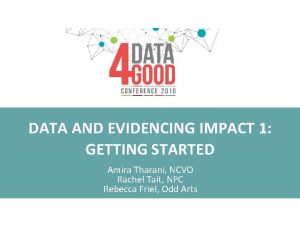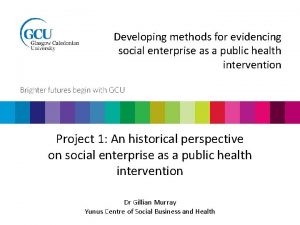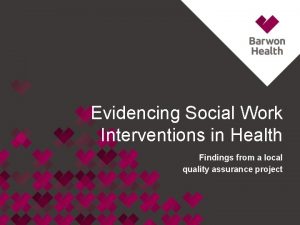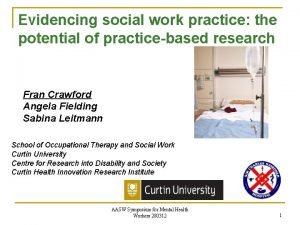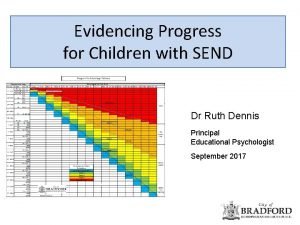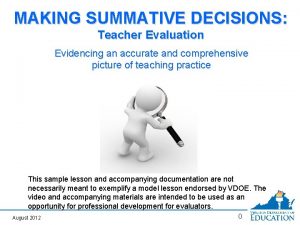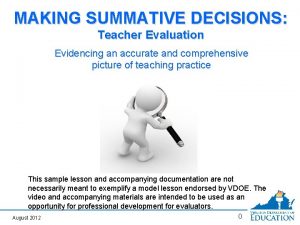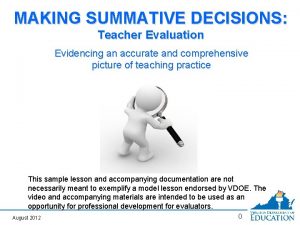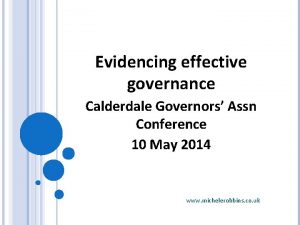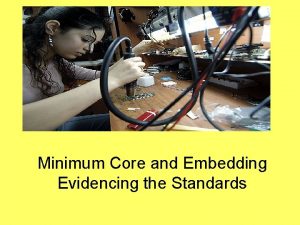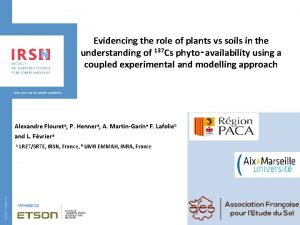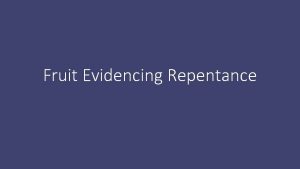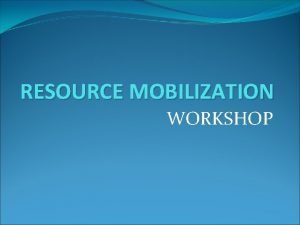Evidencing the Impact a resource to support the





























- Slides: 29

Evidencing the Impact a resource to support the voluntary sector to evidence the impact of adult learning Link Scotland

Evidencing the Impact 1. 2. 3. 4. 5. Introduction to Learning Link Scotland Introduction to the resource Illustrations of a couple of models How we used them What we learned

Learning Link Scotland We are a national membership organisation for voluntary sector adult learning projects in Scotland. We create and deliver services and projects on policy and practice in adult education.

Learning Link Scotland We receive funding from Scottish Government and one of our outcomes is that: the powerful impact of third sector adult learning on learners’ personal, family, work and community lives is better evidenced at policy level and contributes to the development of a learning society.

Some issues for our members in measuring impact • • Knowing where to start Feeling overwhelmed by options Time Architect or archivist? Linking everything together One method for multiple funders Capacity – who is responsible?

The “Evidencing the Impact” resource The Evidencing the Impact resource builds on the Explaining the Difference pack, published by Learning Link Scotland in 2009 and is a response to calls from the voluntary sector for user-friendly guidance on how to evidence clearly the impact of adult learning on individuals, on communities and on life chances.

The process The resource contains guidance and tools for evaluation. It contains five sections: • Understanding evaluation • Evaluating adult learning • Components of evaluation • Evaluation tools • What to do with your evidence

We aim to provide organisations with: • an understanding of the key national policy drivers to provide context for any evaluation • an opportunity to learn about and reflect on the terminology we use to talk about evaluation (such as “output” and “outcome”) • information about the range of evaluation tools that are available, such as the Logic Model or Return on Investment Framework, outlining their structure and where to find them • information about the various quality frameworks that voluntary sector adult learning providers may need to respond to, such as How Good is our Third Sector Organisation? • signposting to further information and guidance about evaluation and evidencing impact.

A couple of models we used • Logic Model • Return on Investment Model

Logic Model A logic model tells the story of your project or programme in a diagram and a few simple words. It shows a causal connection between the need you have identified, what you do and how this makes a difference for individuals and communities. You can use logic modelling to plan a project or programme (as an “architectural” approach), or to examine and record ways in which a project or programme has produced outcomes after it has ended (as an “archaeological” approach). The logic model reflects organisations’ particular contexts, purposes, circumstances and focuses of interest. Therefore different organisations’ logic models will vary in focus and might look dissimilar.

Logic Model NEED INPUT Headache Pills ACTIVITY OUTCOME Take pills Get better

Logic Model - Online tutorial



Logic Model – case study • Emma Whitelock – Lead Scotland (Linking Education and Disability)

Return on Investment Evaluation Planning The measurement of “return on investment” usually refers to financial reward that follows financial investment. However, it can be used to measure the success of a project or programme according to any number of indicators that you are seeking. It is particularly useful for planning for impact before or at the start of a project or programme (for example, a pilot learning programme).

Return on Investment Evaluation Planning How to plan to measure return on investment: • Identifying stages of the programme • Identifying outcomes and indicators • Identifying evidence sources

‘Computing for Dads’ Stage 1: engagement of learners Outcome: • we want single dads in this area to see the relevance of the computing course to them Indicators: • 60% of the open day attendees sign up for more information Evidence: • sign-up sheet

Return on Investment Evaluation Planning • This video features Karen Adams of NHS Education for Scotland describing the ways in which she and her organisation have used return on investment methods as a way of evidencing the impact of projects. • This document illustrates her plan


Illustrations of ways people have used this resource Mini case study 1 Scottish Language Dictionaries had developed a free, downloadable app to enable users of Scots to check and learn Scots words. The organisation wanted to launch the app at a high school and to involve the local community. They were keen to measure and record the impact of the event itself in order to assess whether such events should be replicated with future resources.

Illustrations of ways people have used this resource Mini case study 1 Elaine Webster, the education and outreach officer, said: Evidencing the Impact supported our focus on increasing the impact of our resources. It gave a framework which demonstrated the complexity of impacts, assumptions and the short/medium and long-term aspects of impact. Communicating this in a diagrammatic way is (and will be) useful for discussion with current and potential partners as well as internally. It helped identify the key areas to look for evidence. She concluded: It was essential for me to try out a ‘worked example’ to check my understanding. I worked through the ‘outputs’ and ‘outcomes’ examples and read the background material which I was comfortable with but applying the toolkit to a ‘worked example’ really tested and clarified my understanding.

Illustrations of ways people have used this resource Mini case study 2 A local authority adult learning service in a rural area wanted to plan how to reach more single dads in the community and bring them into adult literacies learning. The focus of the learning would be on the dads’ own learning, as well as their children’s. The adult learning co-ordinator worked with two of her staff over two afternoons to create a logic model. The logic model would help them to plan the best what they needed to invest and do in order to achieve particular outcomes for this group of individuals. The process enabled them to challenge and justify key assumptions (for example, that parents improving their skills will impact on their children’s achievement), to consider external factors that might help or hinder the process, and then to think through in detail what needed to happen in terms of engagement and delivery of the programme. It also helped them to think through how they would measure the impact of the programme after its completion.

Illustrations of ways people have used this resource Mini case study 2 The co-ordinator said: We felt clearer about what evidence we are looking for … we have a clearer idea before we start a project and we have a clearer idea of what we want to achieve at the end of a project. We feel we have a more focussed approach instead of just seeing how it goes.

What we learned Feedback from the refresh provided clearning points that future users of the resource might benefit from reflecting on: • the importance of dialogue in the evaluation process – it is not a process to be undertaken by an individual in a room on their own; rather it should actively involve colleagues, service users, partner organisations and others. In the pilot, dialogue appeared to be key to the successful development of some organisations’ logic models.

What we learned Feedback from the refresh provided clearning points that future users of the resource might benefit from reflecting on: the process of evaluation and evidencing impact was often thought by participants to be as, if not more, important than the final documentary evidence – participants said that they enjoyed and found value in the chance to reflect deeply, consider projects from multiple angles, and to engage with colleagues and partners as they did this.

What we learned Feedback from the refresh provided clearning points that future users of the resource might benefit from reflecting on: • assumptions you make should be reflected on as a fundamental part of the evaluation process – identifying assumptions you are making can be very challenging; for example, if you are assuming that family learning makes a positive difference to outcomes for children and their parents, then do you have evidence to support this, in case you were asked to provide it? By identifying assumptions you are ensuring you are clear in your justification for a particular project or programme, or for undertaking it in a particular way.

What advice would you give to other organisations about measuring impact? • Start the process when making funding applications as it will help articulate what you hope to achieve and enable you to get a project off to a flying start with clarity of purpose and how success will be measured. • Share as widely as possible in your organisation both formally and informally. Widespread adoption of the logic modelling will help to maintain clarity of purpose and help to inform stakeholders of the social value of your work. • Evidencing the Impact is a handy gateway to a range of evaluation tools and the legislative framework in which they operate but is not a short cut to demonstrating the impact of your work. Tim Green, Education Development Manager, South East Scotland

Find out more www. learninglinkscotland. org. uk jhowie@learninglinkscotland. org. uk
 Resource loading vs resource leveling
Resource loading vs resource leveling Perbedaan antara resource loading dan resource levelling
Perbedaan antara resource loading dan resource levelling Minor and major details
Minor and major details đặc điểm cơ thể của người tối cổ
đặc điểm cơ thể của người tối cổ Tỉ lệ cơ thể trẻ em
Tỉ lệ cơ thể trẻ em Các châu lục và đại dương trên thế giới
Các châu lục và đại dương trên thế giới ưu thế lai là gì
ưu thế lai là gì Môn thể thao bắt đầu bằng chữ f
Môn thể thao bắt đầu bằng chữ f Tư thế ngồi viết
Tư thế ngồi viết Thẻ vin
Thẻ vin Hát kết hợp bộ gõ cơ thể
Hát kết hợp bộ gõ cơ thể Cái miệng xinh xinh thế chỉ nói điều hay thôi
Cái miệng xinh xinh thế chỉ nói điều hay thôi Mật thư anh em như thể tay chân
Mật thư anh em như thể tay chân Từ ngữ thể hiện lòng nhân hậu
Từ ngữ thể hiện lòng nhân hậu Trời xanh đây là của chúng ta thể thơ
Trời xanh đây là của chúng ta thể thơ Tư thế ngồi viết
Tư thế ngồi viết V cc cc
V cc cc Voi kéo gỗ như thế nào
Voi kéo gỗ như thế nào Thể thơ truyền thống
Thể thơ truyền thống Hươu thường đẻ mỗi lứa mấy con
Hươu thường đẻ mỗi lứa mấy con Thế nào là hệ số cao nhất
Thế nào là hệ số cao nhất Diễn thế sinh thái là
Diễn thế sinh thái là Ng-html
Ng-html Vẽ hình chiếu vuông góc của vật thể sau
Vẽ hình chiếu vuông góc của vật thể sau 101012 bằng
101012 bằng Thế nào là mạng điện lắp đặt kiểu nổi
Thế nào là mạng điện lắp đặt kiểu nổi Lời thề hippocrates
Lời thề hippocrates Vẽ hình chiếu đứng bằng cạnh của vật thể
Vẽ hình chiếu đứng bằng cạnh của vật thể Tư thế worm breton là gì
Tư thế worm breton là gì đại từ thay thế
đại từ thay thế
































